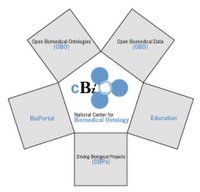Saturday, January 28, 2006
SiberLogic, XML, RDF, and OWL
SiberLogic, XML, RDF, and OWL: SiberLogic, based in Toronto, has some very interesting products that seem to be putting it all together. "SiberLogic today offers a complete and cost-effective environment for teams producing technical documents. A flexible family of products provides not only fundamentals such as version and workflow control, conditional and multi-channel publishing, and staging & deployment options, but also leading-edge functionality that includes semantic enablement via emerging standards such as OWL and RDF, full DITA and S1000D support, real-time fragment reuse analysis, and dynamic generation of a cross-platform knowledge base."
SMEs Get Better Targeted Web Searches
IST Results - SMEs get better targeted Web searches: "'The problem with existing search engines, especially for SMEs seeking an exact response to a query, is that they find many hundreds of sites that may be of little use,' says Sonia Bergamaschi of the University of Modena in Italy and coordinator of the IST project SEWASIE that developed the engine. 'Our idea was to develop a set of ontologies related to specific industry sectors, in order to limit the search to sites that are really useful.'"
Thursday, January 26, 2006
Rescentris Releases Version 2.5 of its Semantic Notebook, CERF - The ELN for Biology
Rescentris Releases Version 2.5 of its Semantic Notebook, CERF - The ELN for Biology: "Rescentris, Ltd., a leading provider of electronic laboratory notebook (ELN) software for biology and multi-disciplinary life sciences, today announced the immediate availability of CERF 2.5 and the CERF Development Kit (CERF-DK) to help life sciences organizations better manage their research information. CERF (Collaborative Electronic Research Framework(TM)) is the industry's only ELN built on semantic web technologies. The semantic engine in CERF enables it to capture the meaning and relationships in R&D information as well as the experimental context in which data are collected - all transparently, while the scientists do their work."
Labels:
Semantic Notebook,
Semantic Web,
semantics
Wednesday, January 25, 2006
A Semantic Solution to Finding Information among Peers
IST Results - A semantic solution to finding information among peers: "Peer-to-peer systems have advantages over centralised server-reliant networks, but finding information among multiple distributed databases can prove difficult. European researchers solved the problem by adding Semantic Web technology to P2P networks."
Sunday, January 22, 2006
The Shape of i-Technology to Come @ SYS-CON AUSTRALIA
LinuxWorld Viewpoints: The Shape of i-Technology to Come: According to Danny Ayers: "The rebranding of the Semantic Web as 'Semantic Technologies' and 'Web of Data' will enable previously dismissive pundits to hype it as the Next Big Thing. There will be real growth in these areas, but not as yet meteoric. Yahoo! will reveal its answer to Google Base, built using Semantic Web technologies. Nokia will join VoIP to the Semantic Web."
. . . .
Support for RSS in Microsoft Vista and Internet Explorer 7 will be indistinguishable from Windows 95’s Active Channels following the company’s removal of new features due to security concerns. There will be massive growth in enterprise-oriented knowledge management systems based on RSS and Atom. There will be a new generation of RSS/Atom aggregators exploiting data published using XHTML microformats and Structured Blogging."
. . . .
Support for RSS in Microsoft Vista and Internet Explorer 7 will be indistinguishable from Windows 95’s Active Channels following the company’s removal of new features due to security concerns. There will be massive growth in enterprise-oriented knowledge management systems based on RSS and Atom. There will be a new generation of RSS/Atom aggregators exploiting data published using XHTML microformats and Structured Blogging."
Thursday, January 12, 2006
National Center for Biomedical Ontology
 National Center for Biomedical Ontology: "The National Center for Biomedical Ontology is a consortium of leading biologists, clinicians, informaticians, and ontologists who develop innovative technology and methods that allow scientists to create, disseminate, and manage biomedical information and knowledge in machine-processable form. The Center's resources include the Open Biomedical Ontologies (OBO) library, the Open Biomedical Data (OBD) repositories, and tools for accessing and using this biomedical information in research. The Center collaborates with biomedical researchers conducting Driving Biological Projects (DBPs) to enable their research and to stimulate technology development in the Center. The Center is undertaking outreach and educational activities to train the future generation of researchers in using biomedical ontologies and the Center's tools to enhance scientific discovery."
National Center for Biomedical Ontology: "The National Center for Biomedical Ontology is a consortium of leading biologists, clinicians, informaticians, and ontologists who develop innovative technology and methods that allow scientists to create, disseminate, and manage biomedical information and knowledge in machine-processable form. The Center's resources include the Open Biomedical Ontologies (OBO) library, the Open Biomedical Data (OBD) repositories, and tools for accessing and using this biomedical information in research. The Center collaborates with biomedical researchers conducting Driving Biological Projects (DBPs) to enable their research and to stimulate technology development in the Center. The Center is undertaking outreach and educational activities to train the future generation of researchers in using biomedical ontologies and the Center's tools to enhance scientific discovery."
Saturday, January 07, 2006
IST Results - Semantic Web Travel Services on a Voyage of Discovery
"Opening up travel Web services
The industry is making moves to improve the situation, and has formed a consortium called the Open Travel Alliance (OTA). The OTA is producing XML message specification schemas to be exchanged between the trading partners, including availability checking, booking, rental, reservation, query services, insurance. This will improve matters, but not every travel company's applications can be expected to produce and consume OTA-compliant messages.
The SATINE project developed a secure peer-to-peer network that enables peers to deploy their semantically-enriched travel Web services and allows others to discover these services semantically. 'The concept, 'semantic web services', is very important for the tourism industry since the industry is structured as a distributed environment, because of its nature, and tourism companies need to reach the services in this distributed environment,' says Dr Dogac. 'By introducing semantics to Web services, we have addressed the interoperability issue on the semantic level and constructed a peer-to-peer network that eases service discovery.'
'The concept, 'semantic web services', is very important for the tourism industry since the industry is structured as a distributed environment, because of its nature, and tourism companies need to reach the services in this distributed environment,' says Dr Dogac. 'By introducing semantics to Web services, we have addressed the interoperability issue on the semantic level and constructed a peer-to-peer network that eases service discovery.'
The project also developed mechanisms to enrich ebXML (e-business XML) registries through OWL-S ontologies to describe the Web service semantics. OWL itself is a markup language for publishing and sharing data using ontologies on the Web. Ontologies are the vocabularies that allow machines to identify specific services or information. For example, a human operator would understand the term 'booking', but it needs to be defined in a special way for a machine to understand. "
The industry is making moves to improve the situation, and has formed a consortium called the Open Travel Alliance (OTA). The OTA is producing XML message specification schemas to be exchanged between the trading partners, including availability checking, booking, rental, reservation, query services, insurance. This will improve matters, but not every travel company's applications can be expected to produce and consume OTA-compliant messages.
The SATINE project developed a secure peer-to-peer network that enables peers to deploy their semantically-enriched travel Web services and allows others to discover these services semantically.
 'The concept, 'semantic web services', is very important for the tourism industry since the industry is structured as a distributed environment, because of its nature, and tourism companies need to reach the services in this distributed environment,' says Dr Dogac. 'By introducing semantics to Web services, we have addressed the interoperability issue on the semantic level and constructed a peer-to-peer network that eases service discovery.'
'The concept, 'semantic web services', is very important for the tourism industry since the industry is structured as a distributed environment, because of its nature, and tourism companies need to reach the services in this distributed environment,' says Dr Dogac. 'By introducing semantics to Web services, we have addressed the interoperability issue on the semantic level and constructed a peer-to-peer network that eases service discovery.'The project also developed mechanisms to enrich ebXML (e-business XML) registries through OWL-S ontologies to describe the Web service semantics. OWL itself is a markup language for publishing and sharing data using ontologies on the Web. Ontologies are the vocabularies that allow machines to identify specific services or information. For example, a human operator would understand the term 'booking', but it needs to be defined in a special way for a machine to understand. "
Tuesday, January 03, 2006
When Sir Tim Berners-Lee Starts Blogging . . . .
 The Father of the Web Joins the Blogosphere: "On December 12, 2005, accordingly, the first-ever blog entry by Sir Tim Berners-Lee went online. And within days no fewer than 455 comments accumulated."
The Father of the Web Joins the Blogosphere: "On December 12, 2005, accordingly, the first-ever blog entry by Sir Tim Berners-Lee went online. And within days no fewer than 455 comments accumulated."
Subscribe to:
Posts (Atom)